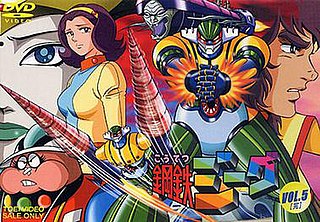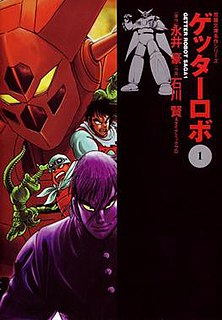
The term mecha may refer to both scientific ideas and science fiction genres that center on giant robots or machines (mechs) controlled by people. Mechas are typically depicted as humanoid mobile robots. The term was first used in Japanese (meka) after shortening the English loanword mekanicalu ('mechanical'), but the meaning in Japanese is more inclusive, and "robot" (robotto) or "giant robot" is the narrower term.

Gundam , also known as the Gundam series , is a science fiction media franchise created by Sunrise that features giant robots (mecha) with the name "Gundam". The franchise began on April 7, 1979 with Mobile Suit Gundam, a TV series that defined the "real robot" mecha anime genre by featuring giant robots called mobile suits in a militaristic setting. The popularity of the series and its merchandise spawned a franchise that includes television series, OVAs, films, manga, novels and video games, as well as a whole industry of model robots known as Gunpla.

Yoshiyuki Tomino is a Japanese mecha anime creator, animator, songwriter, director, screenwriter and novelist. He was born in Odawara, Kanagawa Prefecture, and studied at Nihon University's College of Art. He is best known for creating the Gundam anime franchise.

RahXephon is a 26-episode anime television series created and directed by Yutaka Izubuchi. The series follows 17-year-old Ayato Kamina, his ability to control a mecha known as the RahXephon, and his inner journey to find a place in the world. His life as a student and artist in Tokyo is suddenly interrupted by a mysterious stalker, strange planes invading the city and strange machines fighting back.

Yoshikazu Yasuhiko is a Japanese animator, manga artist, and occasional director in the anime industry.

UFO Robot Grendizer , also known as Force Five: Grandizer in the United States, is a Japanese Super Robot anime television series and manga created by manga artist Go Nagai. It is the third entry in the Mazinger trilogy. The anime television series was produced by Toei Doga and Dynamic Planning and broadcast on Fuji TV from October 5, 1975, to February 27, 1977, and lasted 74 episodes. The robot's first appearance in the United States was as a part of the Shogun Warriors line of super robot toys imported in the late 1970s by Mattel, then in Jim Terry's Force Five series, both under the title Grandizer. It is still widely popular in the Middle East, and it was especially popular in France and Quebec, as well as among French speaking Canadians in the province of New Brunswick, where it was aired under the title Goldorak. It was also very popular in Italy, where it was aired under the title Goldrake, starting in 1978.

Steel Jeeg , also known as Kotetsu Jeeg or Koutetsu Jeeg, is a super robot anime and manga series created by manga artists Go Nagai and Tatsuya Yasuda. The anime television series was produced by Toei Doga. It was first broadcast on Japanese TV in 1975. The series lasted for 46 episodes. Steel Jeeg also ran as a manga in several children's publications.

Getter Robo is a Super Robot manga series created by Ken Ishikawa and Go Nagai, as well as an anime series produced by Toei Animation. The series was broadcast on Fuji TV from April 4, 1974 to May 8, 1975, with a total of 51 episodes. The manga was serialized in Shogakukan's Weekly Shōnen Sunday from April 7, 1974 to August 24, 1975.

IGPX: Immortal Grand Prix refers to two anime series co-produced simultaneously by Cartoon Network and Production I.G. The first is a "microseries" consisting of five 5-minute episodes, and the second is a 26-episode animated series loosely related to the first.
Chogokin is Japanese for "Super Alloy" and is a fictitious material which first appeared in Go Nagai's Mazinger Z manga and anime. It was later adopted by Popy in 1972 as the name of a new line of die-cast metal robot and character toys sold in Japan. The first of these toys was the "GA-01" Mazinger Z, which, in spite of questionable engineering that led Popy to offer a free replacement campaign, ignited a craze that changed the face of the Japanese toy industry in the 1970s. Bandai, the parent company of Popy, continues the Chogokin line to this day, branded under their own name.
Getter Robo G , also known as Force Five: Starvengers in the United States, is a super robot anime series created by Go Nagai and Ken Ishikawa and produced by Toei Animation. This direct sequel to Getter Robo was broadcast on Fuji TV from May 15, 1975 to March 25, 1976, with a total of 39 episodes.
The Brave series is a toy and anime franchise that began after toy company Takara had ended the animated "Generation One" storyline of Transformers in Japan. Following a decline in the series' popularity that led to the cancellation of the OVA series Transformers: Zone, Takara struck a cooperative deal with the animation studio Sunrise to develop a new franchise and set of toy lines. The franchise, in fact, would play a key role in the reintroduction of the Super Robot genre to the Japanese mainstream in the 1990s.

Tadao Nagahama was a director of both puppet shows and animation.

Six God Combination God Mars is a mecha anime television series that was popular during its broadcast between 1981 and 1982 in Japan, Hong Kong, and Italy. The series consists of 64 episodes and 2 movies. Other loosely translated names are "Hexademon Symbiote God Mars", "Six God Union God Mars", and "Six Gods United As One Being"; sometimes spelling the title mecha as "Godmars".

Mecha anime and manga, known in Japan as robot anime and robot manga , are anime and manga that feature robots (mecha) in battle. The genre is broken down into two subcategories; "super robot", featuring super-sized, implausible robots, and "real robot", where robots are governed by realistic physics and technological limitations.
Mitsuru Hongo is a Japanese anime director of television and film.
Hoshikawa is a Japanese surname. Notable people with the surname include:

Mazinger Z is a Japanese super robot manga series written and illustrated by Go Nagai. The first manga version was serialized in Shueisha's Weekly Shōnen Jump from October 1972 to August 1973, and it later continued in Kodansha TV Magazine from October 1973 to September 1974. It was adapted into an anime television series which aired on Fuji TV from December 1972 to September 1974. A second manga series was released alongside the TV show, this one drawn by Gosaku Ota, which started and ended almost at the same time as the TV show. Mazinger Z has spawned several sequels and spinoff series, among them being Great Mazinger, UFO Robot Grendizer and Mazinkaiser.











